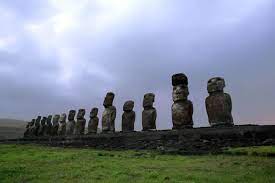This is Scientific American's 60-second Science, I'm Karen Hopkin.
这里是科学美国人——60秒科学系列,我是凯伦·霍普金。
The statues on Easter Island are among the most mysterious objects made by humans. We still don’t know how they were moved, why they were placed at particular sites around the island and why they were made in the first place.
复活节岛上的雕像是人类制造的最神秘的物品之一。我们仍然不知道它们是如何被移动的,为什么它们被放置在岛上的特定地点,为什么它们首先被制造出来。
Now researchers think they have at least some answers, because a new analysis finds that the statues are situated near sources of freshwater.
现在,研究人员认为他们至少找到了一些答案,因为一项新的分析发现,这些雕像坐落在淡水资源附近。
The study appears in the journal PLOS ONE.
这项研究发表在《公共科学图书馆·综合》杂志上。

It’s believed that the residents of Rapa Nui—the Indigenous name for Easter Island—began constructing these carvings in the 13th century.
人们相信拉帕努伊岛(复活节岛的土著名称)的居民从13世纪开始建造这些雕像。
The statues, called moai, which sit upon stone platforms called ahu, are the very definition of monumental.
这些被称为摩埃石像的雕像,坐落在被称为阿胡的石头平台上,是真正意义上的纪念碑。
Most weigh between 20 and 30 tons. And of the 1,000 on the island, about 400 have been moved from the quarry where they originated and placed on ahu located elsewhere.
大多数重量在20到30吨之间。在岛上的1000人中,大约有400人从他们的发源地转移到了别处的胡岛上。
“But those ahu locations aren’t necessarily everywhere. They’re in some places and not in others.
“但并非所有地方都有胡岛。有些地方有,有些地方则没有。
And the question we started to ask ourselves was, ‘Why do we find these ahu and moai some places on the landscape but not others?’”
我们开始问自己的问题是,‘为什么我们在一些地方发现了阿胡和摩埃石像,而在其他地方却没有? ’”
Carl Lipo, an anthropologist at Binghamton University in central New York.
纽约市中心宾厄姆顿大学的人类学家卡尔·利波。
He says that most of these sculptures are found along the coast, but some are inland. And they’re not necessarily at obvious places.
他说,这些雕塑大多是在沿海地区发现的,但也有一些在内陆。它们不一定在明显的地方。
“For example, we don’t find ahu and statues located on the tops of hills—places that we might expect to find them if these things were symbolic or representing ancestors, where you wanted to show off to everybody in he world, or the island itself, the fruits of your creation of these statues.”
“例如,我们没有在山顶发现阿胡和雕像——如果这些东西是象征或代表祖先的话,我们可能会在这些地方发现它们,在那个地方,你想向世界上的每一个人,或整个岛屿炫耀你创造这些雕像的成果。”
So the statues are more than just towering talismans to be admired from afar.
因此,这些雕像不仅仅是可以在远处欣赏的高耸的护身符。
Indeed, Lipo and his colleagues noted that people spent most of their time living and working around these sites, which made the researchers think that the the statues might be located near a valuable resource.
事实上,利波和他的同事们注意到,人们大部分时间都在这些遗址周围生活和工作,这使研究人员认为这些雕像可能位于一种有价值的资源附近。
“So the question was: What resource? Was it water, freshwater, marine resources or cultivation places? Which of those, or which combination of those, best explained the locations of ahu on the landscape?”
所以问题是:什么资源? 是水、淡水、海洋资源还是耕地? 哪一个,或者哪一个组合,最好地解释了阿胡在景观中的位置?”
Their statistical analyses pointed toward potable water, which Lipo says made sense.
他们的统计分析指向了饮用水,利波说这是有道理的。
“Every single time we found a big source of freshwater, there would be a statue and an ahu. And we saw this over and over and over again. And places where we didn’t find freshwater, we didn’t find statues and ahu.”
“每次我们发现一个大的淡水来源,都会有一座雕像和一座阿胡。我们多次看到这种情况。在那些我们没有发现淡水的地方,我们没有发现雕像和阿胡。”
Now, that doesn’t mean that the structures served as markers—like a sign saying “Get Your Water Here”—but rather that the community themselves were connected to those resources. And thus, their investment in statues was done around that resource.
现在,这并不是说这些建筑充当了标记——就像一个写着“在这里取水”的标志——而是说社区本身与这些资源相连。因此,他们对雕像的投资是围绕着这种资源进行的。
“Because these are the locations that had the resources that they needed to survive.”
“因为这些地方有他们生存所需的资源。”
It seems that many of the massive sculptures are where they are for totally pragmatic reasons: “We’ll build here because here is where we want to be.”
似乎许多巨大的雕塑是出于实用主义的考虑:“我们将在这里建造,因为这里是我们想要的地方。”
Thanks for listening for Scientific American's 60-second Science. I'm Karen Hopkin.
谢谢大家收听科学美国人——60秒科学。我是凯伦·霍普金。
文章为可可英语翻译,未经授权请勿转载!











